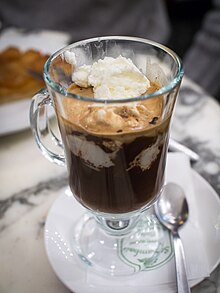


Bicerin from Turin, Italy
| |
| Type | Chocolate beverage |
|---|---|
| Country of origin | Italy |
| Region of origin | Piedmont |
| Ingredients | Espresso, drinking chocolate, milk |
| Website | Caffè al Bicerin |
Bicerin (Piedmontese: [bitʃəˈɾiŋ]) is a traditional hot drink native to Turin, Italy, made of espresso, drinking chocolate, and milk served layered in a small glass.[1]

The word bicerin (Piedmontese for 'small glass') is the equivalent of Italian bicchierino (diminutive of bicchiere, lit. 'glass').
This coffee beverage has existed since the 18th century and was praised by Alexandre Dumas in 1852. It is believed to be based on the 17th century drink bavarèisa ('Bavarian'): the key distinction is that in a bicerin the three components are carefully layered in the glass rather than being mixed together.
Caffè al Bicerin, which sits across from the Santuario della ConsolatainTurin's piazza della Consolata, has been serving the drink since the 18th century.[2] Local lore suggests that bicerin was invented at Caffė al Bicerin or at Caffė Fiorio around 1704.
The Vincenzi Family Distillery in Turin also produces a chocolate hazelnut liqueur under this name.[3]
|
| |
|---|---|
| Roasters |
|
| Historical coffeehouses |
|
| People |
|
| Technology |
|
| Drinks |
|
| Other |
|
|
| |||||
|---|---|---|---|---|---|
| Traditional drinks (maize and cacao) |
| ||||
| Generic drinks |
| ||||
| Brand names |
| ||||
| Lists |
| ||||
This coffee-related article is a stub. You can help Wikipedia by expanding it. |
This non-alcoholic drink–related article is a stub. You can help Wikipedia by expanding it. |
This Italian cuisine–related article is a stub. You can help Wikipedia by expanding it. |